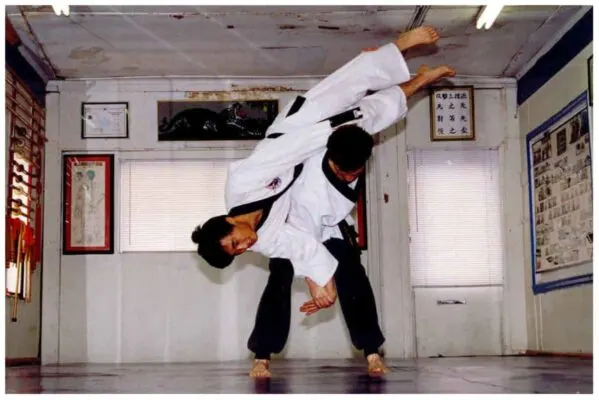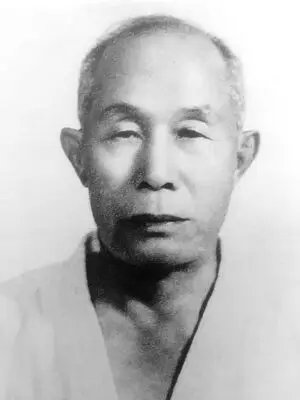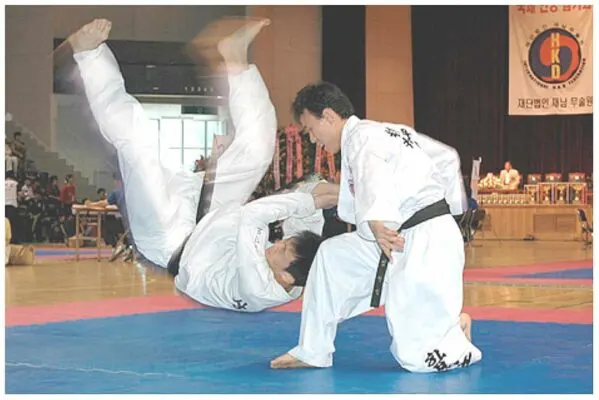
Hapkido is a relatively young martial art compared to other more ancient combat styles with centuries of history. What is Hapkido? How did it come about, and is it an effective self-defense martial art?
Hapkido is a Korean martial art focused on self-defense techniques. It is known for its dynamic and fluid movements that allow practitioners to defend themselves effectively against multiple attackers, regardless of their size or strength. It includes strikes, blocks, throws, and locks.
If you have not heard of Hapkido, we have some interesting information on the foundation of the fighting style, its roots, and its philosophy. This will help you learn more about Hapkido and if it is the right martial art for you to learn for self-defense or discipline and focus.
History Of Hapkido
Hapkido is practiced worldwide and has gained popularity for its practical and effective self-defense techniques. It is also commonly used as a form of physical exercise and to develop mental and emotional discipline.
But let’s learn a little more about the origins of this new martial art, including how it was developed and the roots of the techniques in this fighting style.
What does Hapkido mean?
The name “Hapkido” can be translated to mean “the way of coordinating energy” or “the way of harmony and power.” This name reflects the core principles of Hapkido, which are focused on using an opponent’s energy against them harmoniously and powerfully.
- The meaning of “Hap.” The first part of the word Hapkido, “hap,” can be translated to mean harmony or coordination. This reflects the emphasis on using an opponent’s energy against them rather than trying to overpower them with brute force.
- The meaning of “Ki.” The second part of the word Hapkido, “ki,” can be translated to mean energy or power. This reflects the emphasis on using an opponent’s energy against them in a powerful way. Hapkido practitioners learn to harness their own ki, or life force energy, to execute techniques with maximum efficiency and effectiveness.
- The meaning of “Do.” The final part of the word Hapkido, “do,” can be translated to mean “the way” or “the path.” This reflects the idea that Hapkido is not just a martial art but a way of life. Practitioners are encouraged to apply the principles of Hapkido to all aspects of their lives, striving for harmony and balance in everything they do.
Who created Hapkido?
Hapkido was founded by a Korean martial artist, Choi Yong-Sul (1904-1986). Choi was born in what is now North Korea and was adopted by a Japanese family at a young age. As a young man, he studied martial arts in Japan, including Daito-ryu Aiki jujutsu.

Photo by Tokaria
After World War II, Choi returned to Korea and began teaching martial arts. He combined his knowledge of Daito-ryu Aiki jujutsu with traditional Korean martial arts and his own innovations to create Hapkido.
Choi’s unique approach to martial arts emphasized fluid, circular movements and using an opponent’s energy against them.
Choi’s teachings attracted many students, and Hapkido quickly spread throughout Korea and eventually worldwide. Choi continued to teach and develop Hapkido until he died in 1986.
Although Choi is widely credited as the founder of Hapkido, the martial art has continued to evolve and develop over time, with different schools and practitioners adding their own techniques and approaches to the art.
What does Hapkido focus on?
Hapkido is a martial art that focuses primarily on practical self-defense techniques, emphasizing circular and fluid movements to control an opponent’s energy.
Hapkido is built upon a set of principles that guide the techniques and movements used in the martial art. These principles are essential to understanding the effectiveness and uniqueness of Hapkido.
- The Unity of Opposites. The first principle of Hapkido is the unity of opposites. This principle is based on the concept that everything has an opposite and that these opposites constantly interact. In Hapkido, this principle is applied to the idea of softness and hardness. Practitioners learn to use soft and hard techniques and switch between them seamlessly, depending on the situation.
- The Circle Principle. The circle principle is another important principle in Hapkido. It is based on the idea that circular movements are more efficient and effective than linear movements. In Hapkido, circular movements are used to redirect an attacker’s force, making it easier to control them and defend yourself. This principle is also applied to the concept of flow, as Hapkido practitioners are taught to move in a fluid and continuous manner without stopping or hesitating.
- The Water Principle. The water principle is the final principle of Hapkido. It is based on the idea that water is the most powerful force in nature because it can adapt and flow around obstacles. In Hapkido, practitioners are taught to be like water and adapt to any situation. This principle is closely related to the circle principle, as circular movements are also a key aspect of the water principle.
Together, these principles make Hapkido a highly adaptable and effective martial art. By learning to use both soft and hard techniques, circular movements, and the ability to adapt to any situation, practitioners can defend themselves against any attacker, regardless of their size or strength.
What Are the Main Hapkido Techniques?
Hapkido is a martial art that emphasizes practical self-defense techniques, including joint locks, throws, strikes, and pressure points.
Hapkido does not promote the use of grappling as the belief is that you need to keep distance between you and your attacker to have space to counter their attacks and redirect their energy to your advantage.
- Joint Locks. Joint locks are a central part of Hapkido’s technique. They involve applying pressure to an opponent’s joint in order to cause pain or immobilize them. Joint locks are often used to subdue an attacker without causing them serious injury.
- Throws. Throws are another key technique in Hapkido. They involve using an opponent’s momentum to throw them to the ground. Throws are often used to neutralize an opponent’s attack and create distance between the practitioner and the attacker.
- Strikes. Strikes are also an important part of Hapkido’s technique. They involve using kicks, punches, or other strikes to inflict damage on an attacker. Strikes are often combined with joint locks and throws to subdue an attacker quickly. Hapkido strikes are designed to be powerful and efficient, emphasizing accuracy and precision.
- Pressure Points. Pressure points are specific points located on the body where pressure can be applied to cause pain or discomfort. In Hapkido, pressure points are often combined with joint locks and strikes to subdue an attacker. Some common pressure points used in Hapkido include the temple, the collarbone, and the base of the neck.
Hapkido’s techniques are designed to be practical and effective, allowing practitioners to defend themselves against any type of attack.
Is Hapkido Good for self-defense?
Hapkido is a martial art that is specifically designed for self-defense. Its techniques are practical and effective, and its emphasis on circular and fluid movements allows practitioners to control an opponent’s energy and gain the upper hand in a self-defense situation.
However, every martial art has its weaknesses, so there is no perfect martial art. The main weakness of Hapkido is that no grappling techniques or ground fighting moves are taught.
If your opponent manages to get you on the ground, no techniques in the Hapkido arsenal teach you how to fight from this position.
Another criticism of Hapkido is that the techniques must be executed flawlessly to be effective. Unless you are proficient in Hapkido to a high level, you may not have the time or space to execute the techniques perfectly, rendering them ineffective against a determined attacker.
Does Hapkido Use Weapons?
While Hapkido is primarily known for its unarmed self-defense techniques, it also includes the use of various traditional Korean weapons. Hapkido practitioners learn how to use weapons such as the cane, short stick, long staff, and sword.
Using weapons in Hapkido complements and enhances the practitioner’s unarmed self-defense skills.
It’s worth noting that while weapons are an important part of Hapkido, they are not typically taught to beginners. Students usually begin by learning the basics of unarmed self-defense techniques before progressing to weapon training.
Is Hapkido Hard To Learn?
Learning Hapkido requires time, dedication, and practice, like any martial art. However, whether or not Hapkido is hard to learn depends on several factors, including the individual’s physical abilities, prior experience with martial arts or sports, and learning style.
Some aspects of Hapkido, such as learning the basic movements and techniques, can be relatively easy. These skills can be taught to beginners in a structured way, with a clear progression of skills and techniques.
Advanced techniques require a higher level of physical skill, flexibility, and mental focus. Additionally, Hapkido emphasizes fluid and dynamic movements, which can take time to master.
Hapkido can be a dangerous martial art to study, as you can sustain injuries from forceful contact or damage to joints if locks and holds are not applied correctly. However, this can be said for many other martial arts, such as Aikido, where similar injuries can occur.

Credit: Wikimedia
Hapkido requires dedication and practice, but it’s not necessarily more difficult than other martial arts. The key is finding a qualified instructor and committing to consistent training over time. With dedication and practice, anyone can learn and master the techniques of Hapkido.
How Long Does It Take To Learn Hapkido?
The time it takes to learn Hapkido can vary widely depending on several criteria, including the individual’s natural ability, level of commitment, frequency of training, and the quality of instruction they receive.
Most Hapkido schools divide their curriculum into levels or belts, each indicating a certain degree of proficiency and mastery of Hapkido techniques. The time it takes to progress through these levels can vary from school to school, but generally, it takes several years of consistent training to reach advanced levels.
On average, reaching the black belt level in Hapkido may take around 3-5 years. However, this can vary significantly depending on the individual’s training schedule, natural ability, and level of dedication.
Hapkido is not a martial art that can be learned quickly or easily. It requires consistent practice and dedication over a period of years to truly master the techniques and principles of Hapkido.
Why Is Hapkido Not Popular?
Hapkido is a highly effective martial art with a rich history and a wide range of techniques and skills. However, compared to other martial arts like Brazilian Jiu-jitsu (BJJ) or Taekwondo, Hapkido is relatively less well-known and popular, especially outside of Korea.
- Hapkido is often overshadowed by more well-known martial arts, especially those popularized through media and pop culture.
- Hapkido can be challenging to learn and requires a high level of commitment and practice, which can be a barrier to entry for some people.
- A lack of awareness and understanding about what Hapkido is and what it has to offer.
- Hapkido has many techniques, many of which are complex and take a long time to master.
However, despite its relative lack of popularity, Hapkido remains a highly respected and effective martial art.
RELATED: Do Most Traditional Martial Arts Actually Work?
Is Hapkido the Same as Aikido?
Hapkido and Aikido share similarities in their focus on joint locks, throws, and fluid movements. However, they are distinct martial arts with different origins, techniques, and philosophies.
The similarities between Hapkido and Aikido stem from the fact that both martial arts forms have their roots in Daito-ryu Aiki jujutsu.
Hapkido has a strong influence based on Korean martial arts techniques, while Aikido’s influence is mostly from Japanese martial arts.
Hapkido incorporates some kicks into its techniques, while Aikido does not include any kicks in its array of techniques.
While there are some similarities between Hapkido and Aikido, they are different martial arts with distinct techniques and philosophies. However, practitioners of both arts may find value in studying the other, as they can complement and enrich each other’s training.
Hapkido vs. Taekwondo: Which is Better?
Hapkido and Taekwondo both originated in Korea. While the two have some basic similarities, they are distinct martial arts with different techniques, focuses, and philosophies.
Taekwondo is a martial art primarily focusing on striking techniques, including high and mid kicks, punches, and strikes. It places a strong emphasis on discipline, respect, and self-control.
On the other hand, Hapkido is a martial art that emphasizes practical self-defense techniques, including joint locks, throws, and strikes. It also incorporates aspects of meditation and breathing techniques to develop mental focus and awareness.
Both martial arts have their strengths and weaknesses, and the better option will depend on the individual’s goals and preferences.
For example, Taekwondo may be a better choice for individuals looking for a more rigorous physical workout or those interested in competitive sparring.
Hapkido may be better for those looking to develop practical self-defense skills and a greater emphasis on joint locks and throws.
Ultimately, the decision between Hapkido and Taekwondo will depend on the individual’s goals, preferences, and needs. It may be beneficial to try out both martial arts and see which one resonates with you the most.
Who Should Learn Hapkido?
Hapkido is a martial art that anyone can learn and practice, regardless of age, gender, or physical ability. The techniques and skills taught in Hapkido are adaptable and can be modified to suit the individual’s needs and abilities.
Hapkido is useful for those facing opponents larger and stronger than themselves, which is why it is a popular self-defense style for women. The self-defense focus of the martial art makes it useful for anyone interested in learning self-defense techniques.
People looking to challenge themselves physically and mentally may also find Hapkido a rewarding martial art to study. The techniques and skills taught in Hapkido require practice, dedication, and discipline to master, which can be both challenging and fulfilling.
RELATED: What is Gracie Jiu-Jitsu? Fully Explained
Summary
Hapkido is a dynamic and practical martial art that emphasizes joint locks, throws, strikes, and self-defense techniques. Its lack of popularity outside of Korea is largely due to a lack of general awareness and few dojo’s with proficient instructors to train students in the art.
While Hapkido is not as well-known as other martial arts, such as Karate or Taekwondo, it is still a valuable and effective martial art to study for those interested in practical self-defense, mental and emotional control, and physical conditioning.
